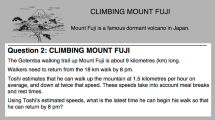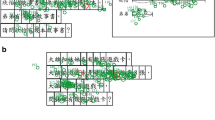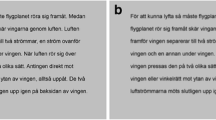Abstract
Is the number of eye fixations a reliable external indicator of internal cognitive processes when subjects are unaware that their eye movements are being monitored electronically? In this study involving college students, there was a relationship between posttest scores and the number of eye fixations, and intelligence level of the subject was correlated with eye fixations.
Similar content being viewed by others
References
Anderson, I. Studies in the eye movements of good and poor readers.Psychological Monographs, 1937,48, 1–35.
Baron, L. Interaction between television and child-related characteristics as demonstrated by eye movement research.Educational Communication and Technology Journal, 1980,28, 267–281.
Dwyer, F.A guide for improving visualized instruction. State College, Pa.: Learning Services, 1972.
Dwyer, F. Color as an instructional variable.Medizinische Welt, 1975,26, 899–904.
Faw, T., & Nunnally, J. The effects on eye movements of complexity, novelty, and affective tone.Perception and Psychophysics, 1967,2, 263–267.
Faw, T., & Nunnally, J. The influence of stimulus complexity, novelty, and affective value on children’s visual fixation,Journal of Experimental Child Psychology, 1968,6, 141–153.
Gould, J. Eye movement during visual search and memory search.Journal of Experimental Psychology, 1973,98, 184–195.
Guba, E., Wolf, W., deGroot, S., Knemeyer, M., Van Atta, R., & Light, L. Eye movements and TV viewing in children.Audiovisual Communication Review, 1964,12, 386–401.
Hochberg, J., & Brooks, V. Film cutting and visual momentum. In J. Senders, D. Fisher, & R. Monty (Eds.),Eye movements and the higher psychological functions. New York: Erlbaum, 1978.
Karsh, R., & Breitenbach, F.Definition of a fixation. Unpublished memorandum, Aberdeen Proving Ground, Md., 1978.
Loftus, G. Eye fixations and recognition memory for pictures.Cognitive Psychology, 1972,3, 525–555.
Loftus, G. A framework for a theory of picture recognition. In R. Monty & J. Senders (Eds.),Eye movements and psychological processes. New York: Erlbaum, 1976.
Mackworth, N., & Morandi, A. The gaze selects information details within pictures.Perception and Psychophysics, 1967,2, 547–551.
Monty, R. Advanced eye movement measuring and recording systems.American Psychologist, 1975,30, 331–335.
Rayner, K. Eye movements in reading and information processing.Psychological Bulletin, 1978,85, 618–660.
Tversky, B. Eye fixations in prediction of recognition and recall.Memory & Cognition, 1974,2, 275–278.
Winer, B.Statistical principles in experimental design (2nd ed.). New York: McGraw-Hill, 1971.
Wolf, W.A study of eye movement in television viewing, Final report. Columbus: Ohio State University, 1970. (ERIC Reproduction Service No. ED 046 254)
Yarbus, A.Eye movements and vision. New York: Plenum Press, 1967.
Zusne, L., & Michels, K. Nonrepresentational shapes and eye movements.Perceptual and Motor Skills, 1964,38, 11–20.
Author information
Authors and Affiliations
Rights and permissions
About this article
Cite this article
Nesbit, L.L. Relationship between eye movement, learning, and picture complexity. ECTJ 29, 109–116 (1981). https://doi.org/10.1007/BF02766781
Issue Date:
DOI: https://doi.org/10.1007/BF02766781




